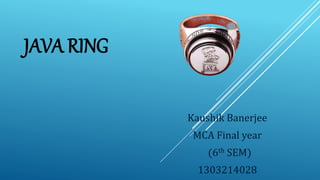
Java ring
- 1. JAVA RING Kaushik Banerjee MCA Final year (6th SEM) 1303214028
- 2. Contents :- Introduction History Components in java ring Working Comparison with smart cards Applications Conclusion reference
- 3. INTRODUCTION A Java Ring is a finger ring that contains a small microprocessor with built-in capabilities for the user. It contains an inexpensive microprocessor in a stainless steel ibutton running a JVM and it is preloaded with applet. The Java Ring is an extremely secure Java-powered electronic token . The Java Ring is a stainless-steel ring, 16-millimeters (0.6 inches) in diameter, that houses a 1-million- transistor processor, called an ibutton. The ring has 134 KB of RAM, 32 KB of ROM, a real-time clock and a Java virtual machine, which is a piece of software that recognizes the Java language and translates it for the user's computer
- 4. JAVA RING Contains a tiny java virtual machine. Implements the Java Card 2.0 API. Store information in Lithium Backed NVRAM(6k) offers high Read/Write speed. Runs Applets. Include microprocessor , Memory , Clock and Battery. It is an extremely secure java-powered electronic token with a continuously running, unalterable real time clock and rugged packaging , suitable for many application. The Ring has 132 KB of RAM,32 KB of ROM.
- 5. History In the summer of 1989, Dallas Semiconductor Corp. produced the first stainless-steel-encapsulated memory device called iButton. IButton is the main component of java ring. Java Ring was introduced at their Java One Conference in March 1998. By 1990,this protocol had been refined and employed in a variety of self- contained memory devices. Originally called “Touch memory” devices , they were later renamed “iButtons”.
- 6. Components In Java Ring JVM RAM ROM Real time clock Ibutton Button Dot Receptor One wire interface
- 8. Blue Dot Receptor Information is transferred between iButton and a PC through Blue Dot Receptor. You simply touch iButton to a Blue Dot receptor. These receptor uses 1-wire communication protocol for data transfer. Has speed up to 142 kbps. Read/Write operation done by RS232C serial port. Information is transferred through the momentary contact.
- 9. Working Java ring is programmed with the applets according to our application. For specific class of user specific java applets is preloaded in to the java ring. All the information of the user is stored in the java ring. User simply presses the signet of the java ring against the “blue dot” receptor and the system connected to the receptor performs the function that the applet instructs to do. Information is transferred between your iButton and a PC with a momentary contact at up to 142kbps. You simply touch your iButton to a Blue Dot receptor or other iButton probe, which is connected to a PC.
- 10. iButtons have an advantage over conventional smart cards in term of durability and longevity. iButtons are rugged enough to withstand harsh environments. iButton uses java as a common programming language. Comparison with smart card
- 11. Applications E-bank application. Providing security in your car. Login into your pc. Storage vault for user names and passwords. E-cash transactions(like in Istanbul). Used by the students at celebration School ,Orlando for lunch. Digital photo-id and fingerprint biometrics.
- 12. Conclusion Highly durable. Java ring is highly durable because of its rugged and secure stainless packing. It is used in personal computing. With its stainless steel armor, it offers the most durable packaging for a class of products that likely will suffer heavy use and abuse as personal possessions. The iButton form factor permits attachment to a wide variety of personal accessories that includes rings, watchbands, key fobs, wallets, bracelets, and necklaces, so the user can select a variation that suits his or her lifestyle. In near future , it will be widely used.
- 13. References Digital Jewellery : An approach to protect jewellery - by Mohit Popat, Prof P.A.Bhalge. Dallas semiconductor ibutton website http://www.ibutton .com http://people.cs.uchicago.edu
